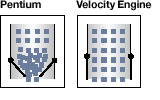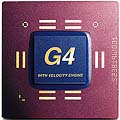Supercomputers have helped achieve breakthroughs in almost every field of science. But almost no one outside the scientific community could possibly need one. Or so it was thought.
That was before Photoshop filters started resembling the most sophisticated image processing done by NASA. And before Internet security started demanding CIA-strength cryptography. And before compressing QuickTime or MP3 files started expanding your workday.
These tasks, and many more like them, have two things in common: They choke traditional processors. And they can be dramatically sped up by exactly the kind of computational horsepower that supercomputers were created to provide.
But who has the money, or even the space, to have a personal supercomputer? Until now.
 PowerPC G4 for Engineering, Science, and Education PowerPC G4 for Engineering, Science, and Education
Requires Adobe Acrobat Reader
What’s a supercomputer?
What makes a supercomputer “super” is its ability to execute at least one billion floating-point operations per second. It’s a staggering measure of speed known as a “gigaflop.”
The PowerPC G4, architected by Apple, Motorola and IBM, is the first microprocessor that can deliver a sustained performance of over one gigaflop — and in fact, has a theoretical peak performance of 5.3 gigaflops.
That’s pretty phenomenal when you consider the fact that it was so few years ago that the University of California at Irvine’s Aeneas Project, for instance, custom-built a one-gigaflops supercomputer for $50,000. Just think how many Power Mac G4s and PowerBook G4s you can buy with that kind of money.
| |

The PowerPC G4 Velocity Engine can process information in 128-bit chunks, compared to the 32 — or 64-bit chunks in traditional processors.
|
The Velocity Engine
The secret of the PowerPC G4’s phenomenal performance is its aptly named Velocity Engine. It’s the heart of a supercomputer miniaturized onto a sliver of silicon. The Velocity Engine can process data in 128-bit chunks, instead of the smaller 32-bit or 64-bit chunks used in traditional processors (it’s the 128-bit vector processing technology used in scientific supercomputers — except that we’ve added 162 new instructions to speed up computations).
In addition, the PowerPC G4 can perform four (in some cases eight) 32-bit floating-point calculations in a single cycle — two to four times faster than traditional processors.
The PowerPC G4 with Velocity Engine works with the PowerPC architecture to accelerate the data-intensive processing required by next-generation video, voice and graphics applications. Among the G4 key features is a vector permute function capable of rearranging data in the registers — a priceless benefit when converting data from one format to another (often necessary with voice, video and graphics apps, which typically need to save data in a number of different formats).
These vector processing acceleration advantages give the G4 microprocessor a significant edge when it comes to fast visualization of large data sets, and intensive math for real-time simulations. Making the PowerPC G4 perfect for everything from digital video, graphics and 3D games to astronomy, the biosciences and predictive modeling.
|
 |
 Taking Advantage of the Velocity Engine
Taking Advantage of the Velocity Engine
“Currently, the G4 is significantly faster than any platform we’ve seen running Photoshop” said John E. Warnock, chairman of Adobe.

A Brief History of Supercomputers
 For the benefit of computer history buffs, Apple’s association with supercomputers goes back to the company’s early days. Story has it that Seymour Cray — founder of Cray Research and father of several generations of supercomputers — heard that Apple had bought a Cray to simulate computer design. Cray was amused, remarking, “Funny, I am using an Apple to simulate the Cray-3.” For the benefit of computer history buffs, Apple’s association with supercomputers goes back to the company’s early days. Story has it that Seymour Cray — founder of Cray Research and father of several generations of supercomputers — heard that Apple had bought a Cray to simulate computer design. Cray was amused, remarking, “Funny, I am using an Apple to simulate the Cray-3.”
By today’s standards, the mastodons of the computer age resembled giant Rube Goldberg contraptions. “The Cray 2 looked even stranger,” Danny Hillis notes in an essay in Forbes magazine. “It bubbled in a bath of fluorocarbon fluid-cooled by artificial blood.”
With names like ENIAC, ILLIAC, EDSAC and RAMAC — in a companion piece, Forbes poetically likens these ancestors of the modern supercomputer to a dynastic line of pharaohs — time was when big iron was not just enormous, it was enormously complicated. But times have changed. Now the Power Mac G4 combines the processing speed of a supercomputer with the ease of use of a Macintosh.
|



